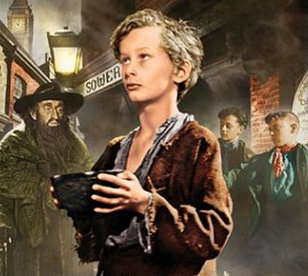
Twisting Dickens:
Analyzing David Lean's Adaptation of Oliver Twist
Home
Critical Essay
Part I
Part II
Part III
Bibliography
Related Web Links
Last Updated: 12/12/2008
Part III: Artistic Depth
Dickens chooses entangled, intricate plots and utilizes a language all his own when painting an image with his words. However, where Dickens must rely on his expansive vocabulary, Lean is able to visualize the scene and project his vision into his film for the viewer’s to witness.
Lean’s choice of lighting, shadow, music, and characterization visually emphasize the characterization and interaction between Oliver, the landscape, and the supporting characters. Lean cast a frail child to play the part of Oliver Twist, invoking the image of frail youth overcoming life’s cruelty. He utilizes dark shadow and harsh light on the pale skin of his young hero to emphasize the harsh and brutal scenes. However, when Oliver is with Mr. Brownlow, Lean uses a warm, sunnier light and the scenery is inviting and friendly. As a viewer you feel the change in Oliver and understand he is going to be protected in Brownlow’s care. Lean is sure to keep viewers aware of the scenes of hopeful warmth, but also of the pail, shining hope which seems to come from the very boy who plays Oliver.
Lean’s vision continually directs the film to capture the essence of innocence in Oliver Twist. Throughout the film, Lean’s choice of music lays out the emotions in a manner words can only describe. When Oliver is first brought to meet the workhouse elders, silence is all that echoes. He is eventually brought into the workhouse where low tones are heard in the background. These low tones set the mood of monotonous work and the loneliness and sadness depicted on the faces of all those working. The music continually changes throughout the film.